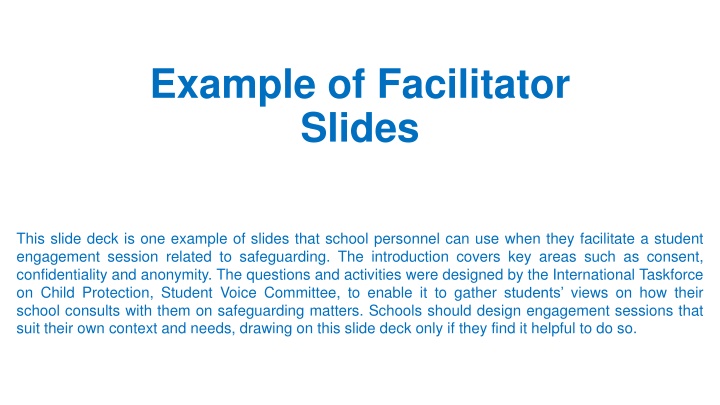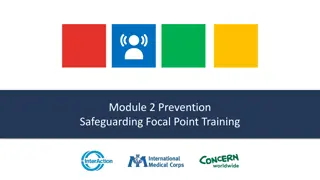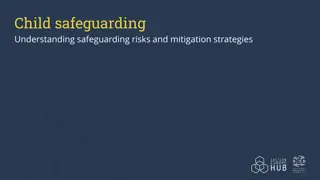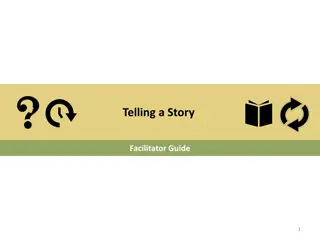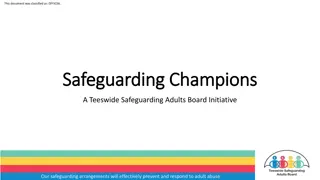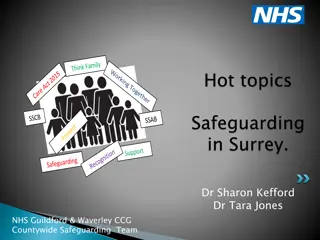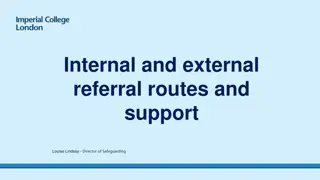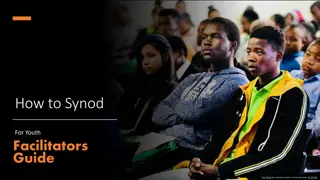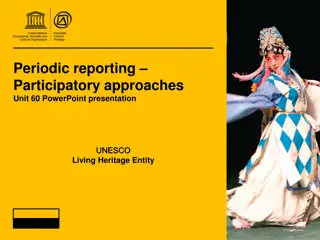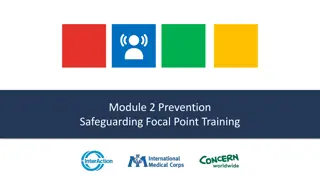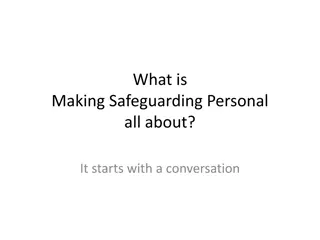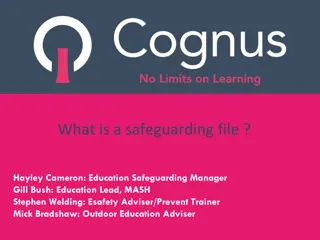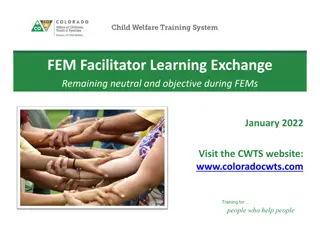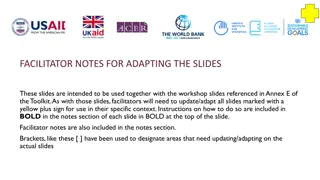Student Safeguarding Engagement Session Facilitator Slides
This slide deck example is designed to facilitate student engagement sessions on safeguarding in schools, covering key areas like consent, confidentiality, and anonymity. The slides include activities created by the International Taskforce on Child Protection, Student Voice Committee, to gather student input on school consultation practices regarding safeguarding. The project aims to enhance student involvement in creating safe school cultures and protecting them from harm, gathering their views on school's safeguarding practices.
Download Presentation

Please find below an Image/Link to download the presentation.
The content on the website is provided AS IS for your information and personal use only. It may not be sold, licensed, or shared on other websites without obtaining consent from the author.If you encounter any issues during the download, it is possible that the publisher has removed the file from their server.
You are allowed to download the files provided on this website for personal or commercial use, subject to the condition that they are used lawfully. All files are the property of their respective owners.
The content on the website is provided AS IS for your information and personal use only. It may not be sold, licensed, or shared on other websites without obtaining consent from the author.
E N D
Presentation Transcript
Example of Facilitator Slides This slide deck is one example of slides that school personnel can use when they facilitate a student engagement session related to safeguarding. The introduction covers key areas such as consent, confidentiality and anonymity. The questions and activities were designed by the International Taskforce on Child Protection, Student Voice Committee, to enable it to gather students views on how their school consults with them on safeguarding matters. Schools should design engagement sessions that suit their own context and needs, drawing on this slide deck only if they find it helpful to do so.
Student Engagement Session 1 [Title] Focus Group 1: [campus, grades]
Purpose This project is exploring how schools can do a better job of involving students in creating safe cultures in schools and protecting students from harm. Throughout our two sessions together, we would like your views on how schools can do a better job of listening to student views about keeping you safe. We are carrying out x number of sessions. The facilitator of each session will prepare a written record and the school s child protection committee will review these and prepare recommendations for how we can improve how we involve students in safeguarding in our school to keep them safe. If you would like to see the report let us know at the end of our sessions.
Facilitator Introductions Photo Photo [name] [role] [name] [role]
Your consent We won t be asking you to talk about personal experiences. Thank you for taking part in this project. We want to be sure that you are comfortable. If you want to talk about personal experiences after the session, then [insert names] Any adult you trust are here for you. Before we begin let s read the consent form and check the correct box for each statement. Or if you want to write down your personal experiences, you can, but you are not asked to. Paper and pens in the room. If you have any questions or worries, we will talk these through now.
Your participation is anonymous. You will not be named or identified. The only reason we might need to pass your name onto someone else would be if you told us something that worried us about your own safety or the safety of someone else. Notes will be taken to record your thoughts, no audio or video. Pictures may be taken of the activities you complete without you in the pictures.
Working Agreement Everyone has a voice and everyone s opinions are valued. We talk only in English so everyone understands. Translation language. Listen carefully. We don t name people, what we talk about stays in the room . To pass on contributing to a discussion turn over the orange card next to you. To take a short break, turn over the red card next to you. If you want to leave the session and not return talk to [X] To show you have something important to say or you want to speak to someone after the session, turn over the green card next to you.
Activity 1: When we described the project to you and when we talk about safeguarding and safety at school: 1. What do you think about? 2. What does safeguarding and safety mean? THINK PAIR SHARE Talk to the person next to you for 3 mins Brainstorm your ideas, writing one idea on a post-it note and be ready to add to our brainstorm and share as a group.
Activity 2: How does the school keep you safe from harm? Together draw a mind-map that shows the ways the school helps to keep you safe from the different kinds of harm. 1. Use the large sheet of paper and the marker pens. 10 mins 2. Together decide which are most important by placing a star next to them.
De-brief Session 1 How are we feeling? Have you any questions or concerns? Anything you now wish to add to the two activities today before we finish? If you d like to talk to someone about something that was discussed today let me know before you leave the room, or you can always speak to any adult you trust in school. If you d like to talk to someone outside of school, here are some organisations that you can reach out to: [helplines, chat support etc.] What we have talked about today, stays in the room . Our next and final session will be: [insert date] Thank you!
Student Engagement Session 1 [Title of session] Focus Group 1: [campus, grades]
Purpose Purpose This project is exploring how schools can do a better job of involving students in creating safe cultures in schools and protecting students from harm. Throughout our two sessions together, we would like your views on how schools can do a better job of listening to student views about keeping you safe. We are carrying out x number of sessions. The facilitator of each session will prepare a written record and the school s child protection committee will review these and prepare recommendations for how we can improve how we involve students in safeguarding in our school to keep them safe. If you would like to see the report let us know at the end of our sessions.
Facilitator Introductions Photo Photo [name] [role] [name] [role]
Your consent We won t be asking you to talk about personal experiences. Thank you for taking part in this project. We want to be sure that you are comfortable. If you want to talk about personal experiences after the session, then [insert names] Any adult you trust are here for you. Before we begin let s read the consent form and check the correct box for each statement. Or if you want to write down your personal experiences, you can, but you are not asked to. Paper and pens in the room. If you have any questions or worries, we will talk these through now.
Your participation is anonymous. You will not be named or identified. The only reason we might need to pass your name onto someone else would be if you told us something that worried us about your own safety or the safety of someone else. Notes will be taken to record your thoughts, no audio or video. Pictures may be taken of the activities you complete without you in the pictures.
Working Agreement Everyone has a voice and everyone s opinions are valued. We talk only in English so everyone understands. Translation language. Listen carefully. We don t name people, what we talk about stays in the room . To pass on contributing to a discussion turn over the orange card next to you. To take a short break, turn over the red card next to you. If you want to leave the session and not return talk to [X] To show you have something important to say or you want to speak to someone after the session, turn over the green card next to you.
Activity 1: Are we (school) listening? This activity asks you to vote with your feet! I will read out a number of statements, you can ask me to explain if you need me to and then I ll ask you to move to the place which most describes how you feel. Be ready to explain why you ve chosen your place AND what suggestions you have for improvement. STRONGLY AGREE_________________________________STRONGLY DISAGREE 4 3 2 1
Statement 1 My school often asks me and other students about how safe and well we feel
Statement 2 My School often asks students for input into how they can do more to keep students safe.
Statement 3 My school asks for students feedback on the ways that it teaches us about safety and adapts the curriculum in light of feedback.
What do you think should be covered in the curriculum?
Statement 4 My school involves students when designing student safety policies and takes student feedback into account.
Statement 5 If I thought my school wasn t doing enough to keep students safe, I would tell a teacher of counsellor.
Statement 6 If I told a teacher or counsellor that I thought the school wasn t doing enough to keep students safe then I am confident that the school would listen to me and make changes to their systems if they could.
Statement 7 My school listens to all students voices equally and doesn t prioritise some students over others.
Activity 2: Changes to ensure students voices are listened to: Activity 2 : Group discussion Choose someone to lead the discussion Choose someone to write your ideas Choose someone to keep time a. You are in charge of and leading the school. What changes would you make to ensure that student s voices are listened to? Advice to school leaders: b. What advice would you give school leaders on how to do a better job of empowering students and keeping them safe?
Activity 3: Discussion Student Leaders We have many different types of student leader at the school. How can we develop the roles of student leaders in safeguarding? What would you like student leaders to do to ensure students feel empowered and safe?
De De- -brief Session 2 brief Session 2 How are we feeling? Is there anything that you have shared over the two sessions that you don t want included in our written record? You can let us know up to [insert date] If there is anything further you want to say, personal thoughts, you can email either of us: [X] or talk to one of our counsellors. You speak to any member of staff you feel comfortable with if you or a friend has experienced harm. [Y] will check in with you individually in the next 48 hours to ask you about your experience. If you would like to read the draft full report please tell me now, this will be around September. Thank you for participating we have really enjoyed talking with you. We will send you an email later today. What we have talked about today, stays in the room . Thank You With thanks to Rachel Edwards for helping to design these slides.
